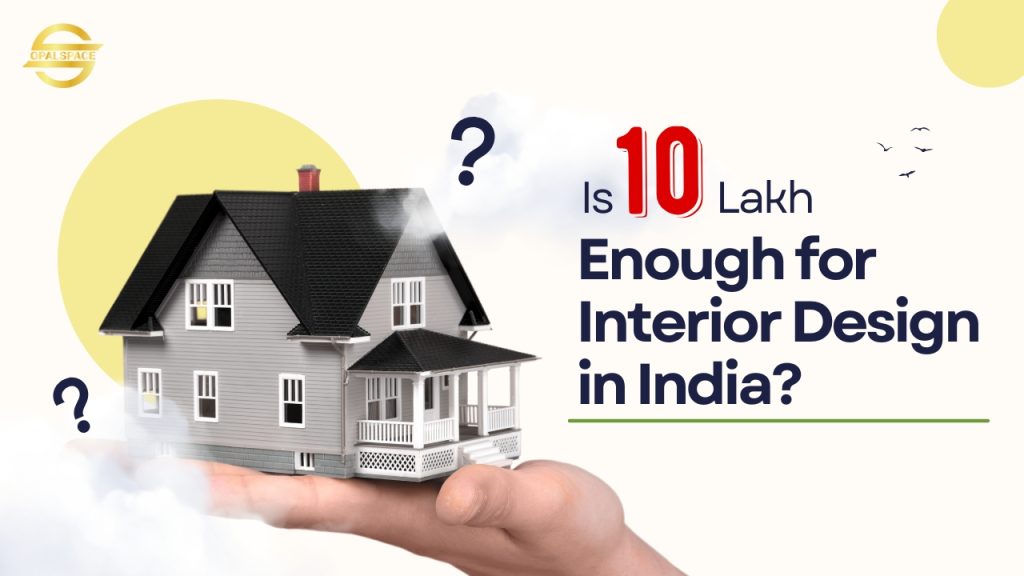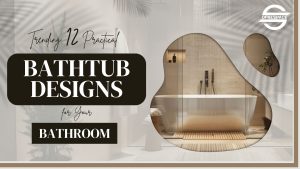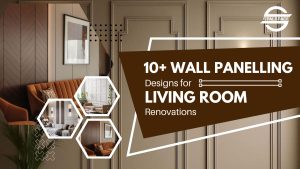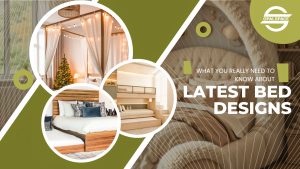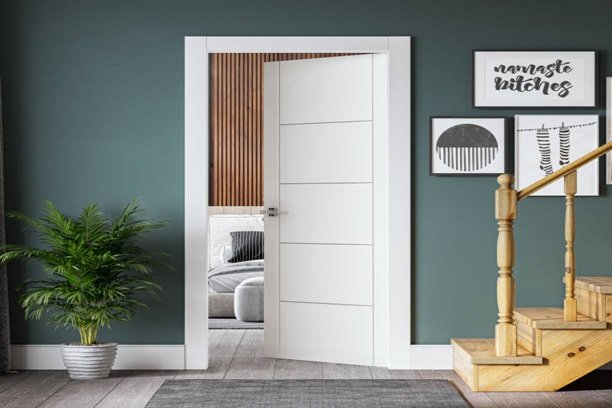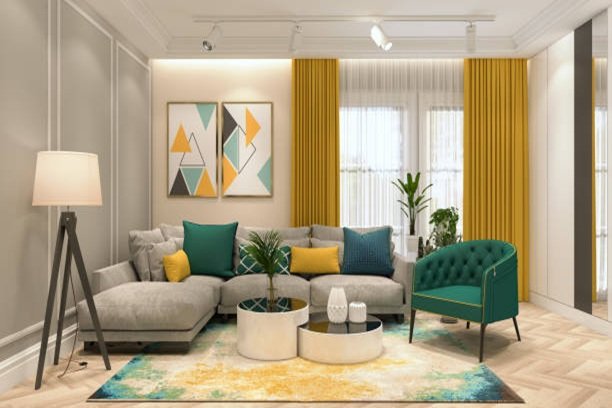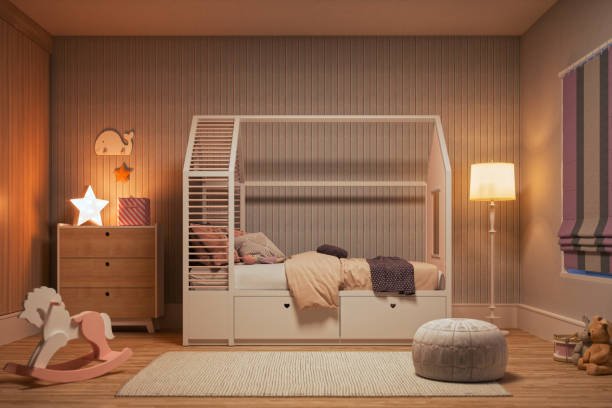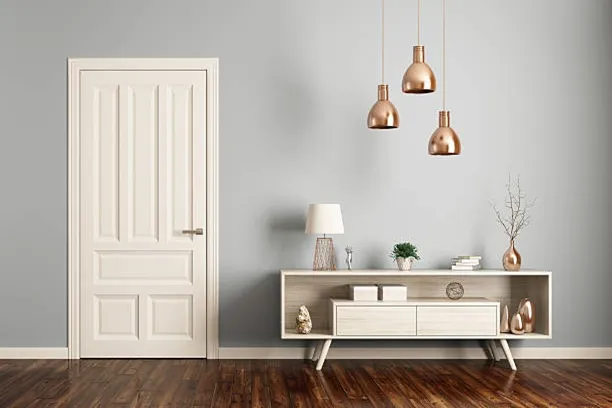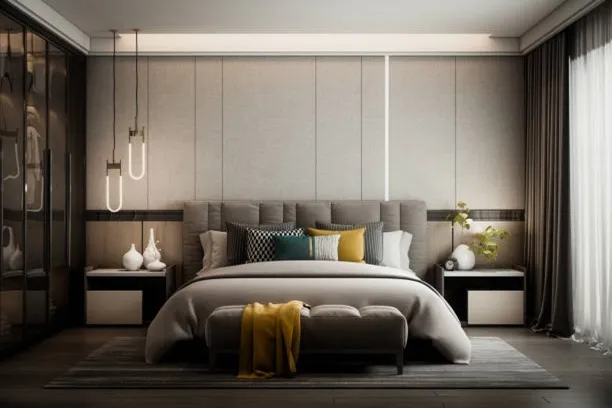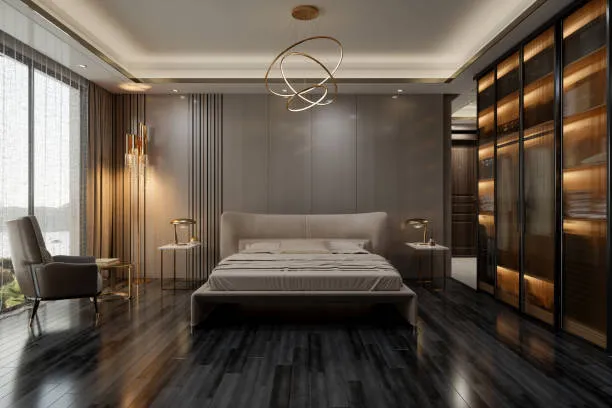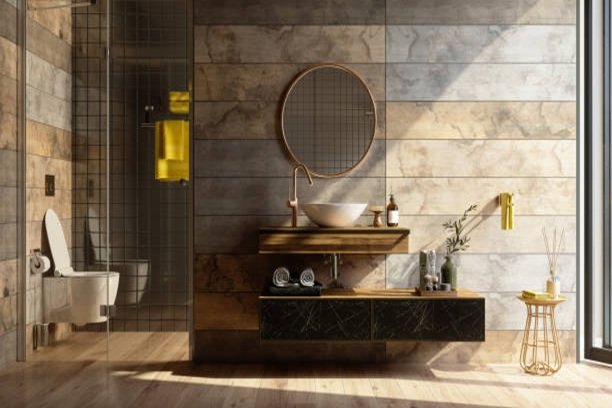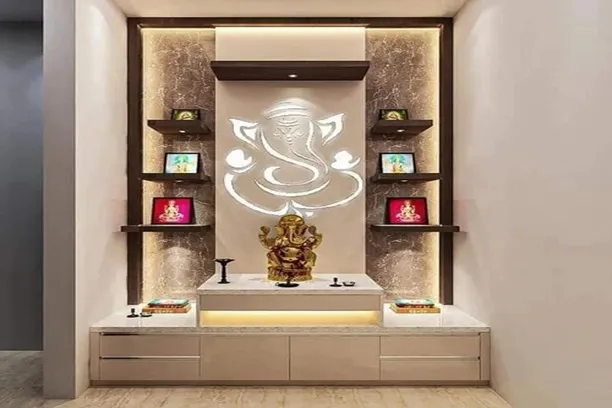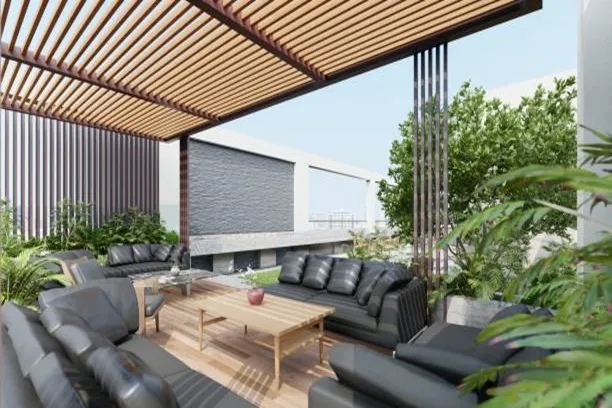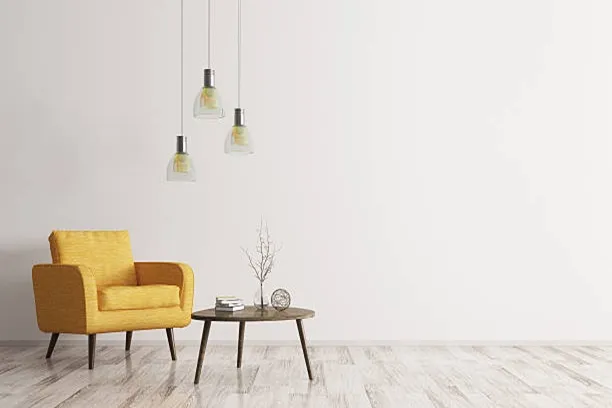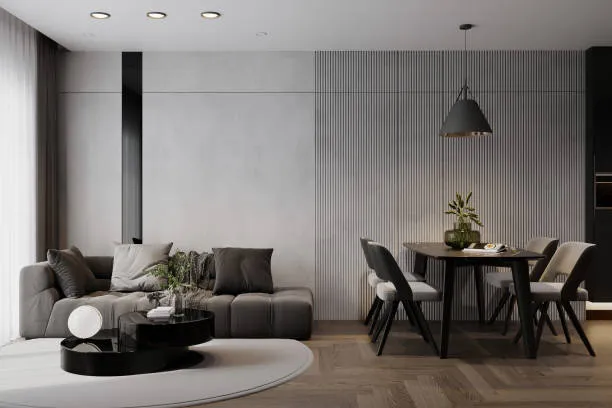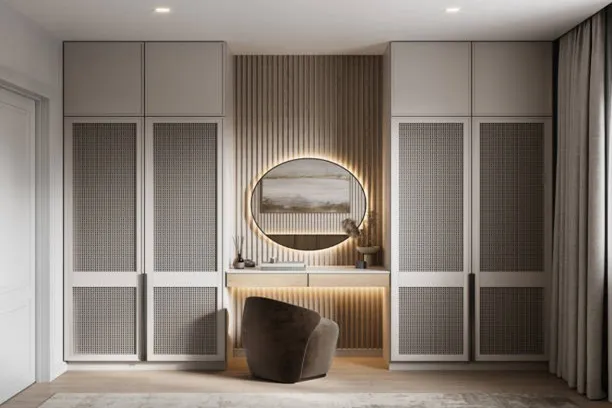Table of Contents
One of the most common questions an interior designer comes across is “How much should I actually budget for doing up my home? How much interior designing cost?” It’s a question that sounds simple, but the answer rarely is, especially in India. Here, the idea of home is deeply personal, yet the realities of space and cost are unavoidable. Compact city apartments to spacious houses in smaller towns, no two homes, or families have identical needs. That’s why budgeting for interiors becomes such an important, and often overwhelming, decision.
Let’s talk about ₹10 lakh. On paper, it feels like a substantial amount. It’s a figure that makes many people feel they can cover everything they want. But is it really enough? That depends on what you expect: Are you imagining a fully modular kitchen, built-in wardrobes in all bedrooms, designer lighting, false ceilings, and custom furniture? Or are you looking for targeting minimalistic interior design ideas? The truth is, ₹10 lakh can get you a lot, or very little, it completely depends on your choices, the size of your home, and where you live. Costs can vary widely between cities, and even within the same city based on the materials you choose and the level of finish you want.
In this blog, Opalspace wants to help you see clearly what ₹10 lakh can realistically achieve. I’ll break down where the money typically goes, explain the key factors that affect your budget, and share practical guidance on how to plan better. By the end, you’ll have a clearer idea of what to expect and how to make the most of the budget you have.
Let’s talk about ₹10 lakh. On paper, it feels like a substantial amount. It’s a figure that makes many people feel they can cover everything they want. But is it really enough? That depends on what you expect: Are you imagining a fully modular kitchen, built-in wardrobes in all bedrooms, designer lighting, false ceilings, and custom furniture? Or are you looking for targeting minimalistic interior design ideas? The truth is, ₹10 lakh can get you a lot, or very little, it completely depends on your choices, the size of your home, and where you live. Costs can vary widely between cities, and even within the same city based on the materials you choose and the level of finish you want.
In this blog, Opalspace wants to help you see clearly what ₹10 lakh can realistically achieve. I’ll break down where the money typically goes, explain the key factors that affect your budget, and share practical guidance on how to plan better. By the end, you’ll have a clearer idea of what to expect and how to make the most of the budget you have.
Is ₹10 Lakh Enough for Interior Design in India?
Yes, but with conditions. ₹10 lakh can be enough for interior design in India, but whether it covers everything you need depends on a few important factors: the size of your home, the city you’re living in, and the kind of interiors you’re aiming for.
Let’s start with home size. A modest 2 BHK in a Tier 2 city might fit well within this budget if you’re opting for functional modular units, basic finishes, and smart space planning. But the same amount might fall short in a metro city, especially if you want premium finishes or custom furniture. In larger homes like 3 BHKs or duplexes, ₹10 lakh usually only covers the essentials, like kitchen, wardrobes, lighting, and maybe one or two accent elements.
Then comes scope of work. If you’re expecting a fully designed home with custom furniture, mood lighting, false ceilings, decor styling, and turnkey execution, ₹10 lakh may not be sufficient. But if your needs are more straightforward, let’s say, modular wardrobes, a functional kitchen, painting, and some smart lighting, you can absolutely work within this limit.
So yes, ₹10 lakh can take you a long way if you plan wisely and prioritise what matters most. The key lies in understanding where the money goes, and being clear about the must-haves versus the nice-to-haves. That’s what we’ll unpack in the next sections.
Then comes scope of work. If you’re expecting a fully designed home with custom furniture, mood lighting, false ceilings, decor styling, and turnkey execution, ₹10 lakh may not be sufficient. But if your needs are more straightforward, let’s say, modular wardrobes, a functional kitchen, painting, and some smart lighting, you can absolutely work within this limit.
So yes, ₹10 lakh can take you a long way if you plan wisely and prioritise what matters most. The key lies in understanding where the money goes, and being clear about the must-haves versus the nice-to-haves. That’s what we’ll unpack in the next sections.
Factors that Decide Your Interior Design Cost
1. Home Size and Layout
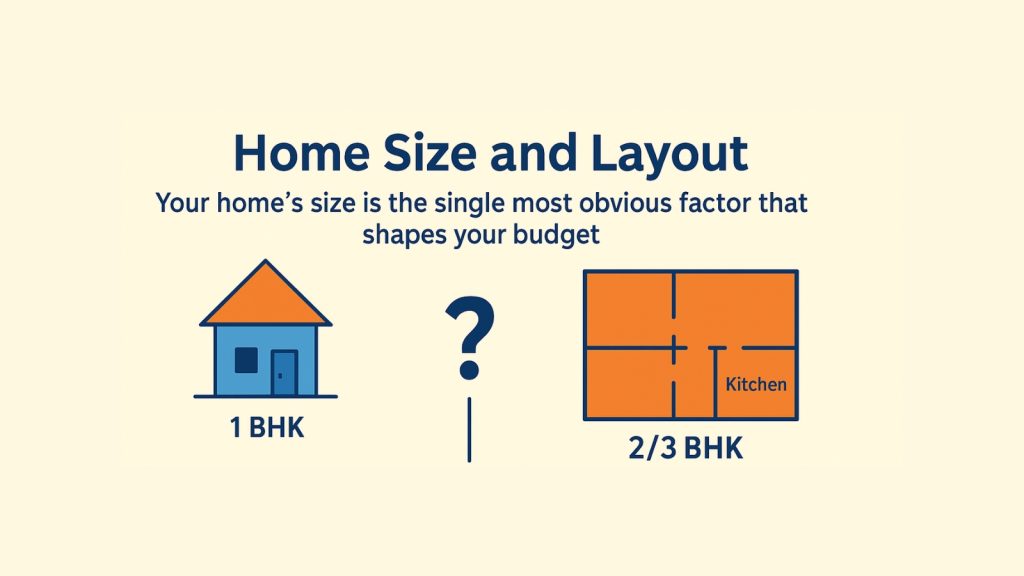
Your home’s size is the single most obvious factor that shapes your budget. A compact 1 BHK can usually be designed functionally within ₹5–7 lakh, and that leaves room for better finishes or a few statement pieces if you stretch to ₹10 lakh. But as you move to a 2 BHK or 3 BHK, you’re dealing with more rooms to furnish, more wardrobes, larger kitchens, and more circulation space to treat. It’s not just about floor area, it becomes about the number of functional zones needing design attention in your home interiors.
The layout also matters. An open-plan kitchen-living area might reduce partition and civil work costs, but it generally demands more integrated cabinetry or smarter lighting to maintain a cohesive look. Similarly, homes with odd and unusual shapes or structural beams may need customised solutions, which can add to your overall home interior design cost.
So when you ask, “Is ₹10 lakh enough?”, the first question is always how big your space is, and how many rooms need work. These are the practical considerations that should guide your layout plan and help you choose the appropriate interior design ideas as per your budget and needs.
The layout also matters. An open-plan kitchen-living area might reduce partition and civil work costs, but it generally demands more integrated cabinetry or smarter lighting to maintain a cohesive look. Similarly, homes with odd and unusual shapes or structural beams may need customised solutions, which can add to your overall home interior design cost.
So when you ask, “Is ₹10 lakh enough?”, the first question is always how big your space is, and how many rooms need work. These are the practical considerations that should guide your layout plan and help you choose the appropriate interior design ideas as per your budget and needs.
2. Scope of Work (Basic vs Premium)
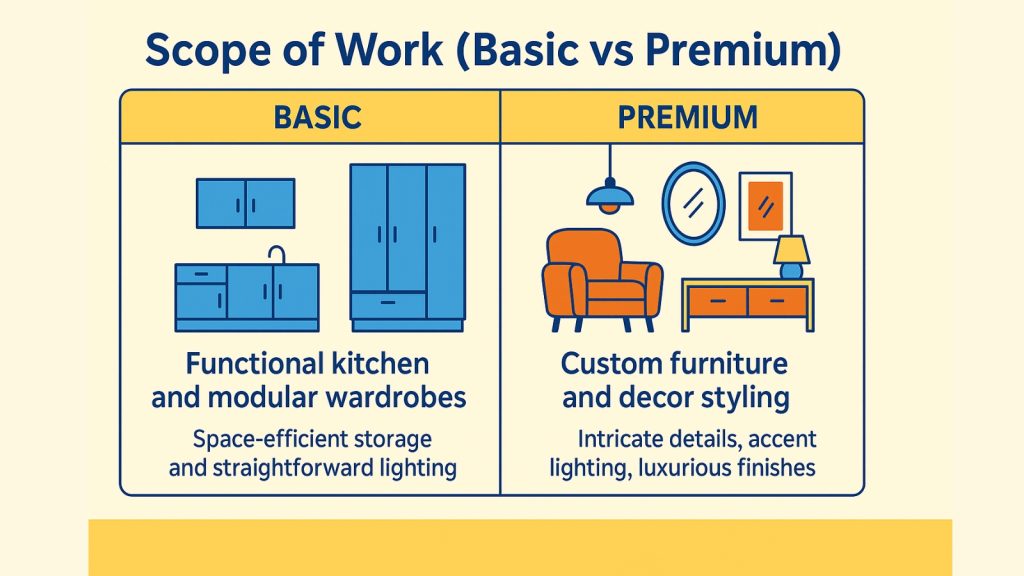
Another critical variable is your scope of work. There’s a world of difference between doing only the essentials, like basic modular wardrobes and a functional kitchen, and going for a premium, fully-designed home with custom furniture, accent lighting, false ceilings, wallpaper, and decor styling.
In my experience, ₹10 lakh can comfortably cover a well-planned basic design for a mid-sized home. But if your expectation is for high-end, luxury interiors, you’ll likely need a larger budget or be ready to prioritise and phase out the work.
- Basic home interior design typically focuses on function, such as space-efficient and well-fitted storage, easy-to-maintain surfaces, straightforward lighting. It’s optimised thoughtfully-planned, though it might not quite match the luxurious ‘showroom’ aesthetic that most people fantasise when browsing interior design ideas on Google or Pinterest.
- Premium design, meanwhile, includes thoughtful detailing, high-quality hardware, intricate finishes, polished carpentry, mood lighting, soft furnishings, and even art curation. These elements add to both beauty and comfort, but they also increase the cost of your home interiors.
In my experience, ₹10 lakh can comfortably cover a well-planned basic design for a mid-sized home. But if your expectation is for high-end, luxury interiors, you’ll likely need a larger budget or be ready to prioritise and phase out the work.
3. Location and City-wise Variation
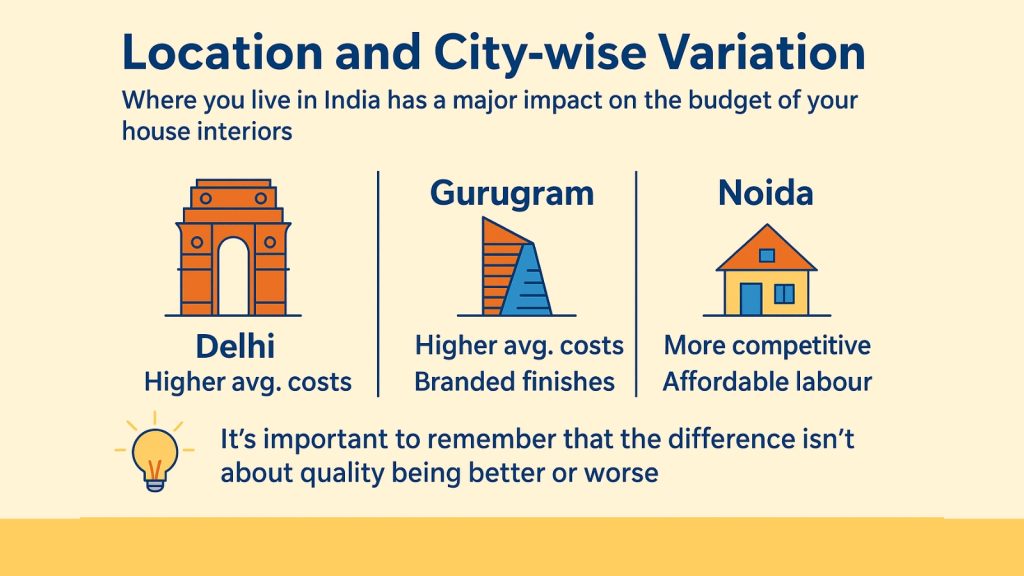
Where you live in India has a major impact on the budget of your house interiors, and this is especially true for the Delhi NCR region. Costs for labour, materials, transportation, and even designer fees can vary noticeably between Delhi, Gurugram, and Noida, even though they’re part of the same metro area.
It’s important to remember that the difference isn’t about quality being better or worse, it’s in fact about understanding the local market dynamics. A ₹10 lakh budget in Gurugram might cover just the essentials with mid-range finishes, while in Noida you might stretch that same budget a bit further, perhaps incorporating additional storage or slightly better materials. That’s why careful planning and local insight matter so much. Before you set your budget expectations, it’s worth talking to designers who work specifically in your area. They know exactly where you can save, where to invest, and how to make your home interiors can work best for you.
- In Delhi and Gurugram, you would see higher average costs for both labour and materials. Premium markets, demand for branded finishes, and sky-rocketing contractor rates can push your budget higher. In fact, modular suppliers in these areas may have a steeper pricing baseline, especially if you’re targeting high-end finishes or custom furniture.
- Noida, in comparison, often offers slightly more competitive pricing. Labour rates tend to be a little more affordable, and local modular vendors or carpenters often provide better value for money while maintaining full functionality. That’s one reason many homeowners here seek out an interior designer in Noida, such as Opalspace, who knows the local suppliers well and can help balance quality with cost.
It’s important to remember that the difference isn’t about quality being better or worse, it’s in fact about understanding the local market dynamics. A ₹10 lakh budget in Gurugram might cover just the essentials with mid-range finishes, while in Noida you might stretch that same budget a bit further, perhaps incorporating additional storage or slightly better materials. That’s why careful planning and local insight matter so much. Before you set your budget expectations, it’s worth talking to designers who work specifically in your area. They know exactly where you can save, where to invest, and how to make your home interiors can work best for you.
4. Choice of Materials and Finishes
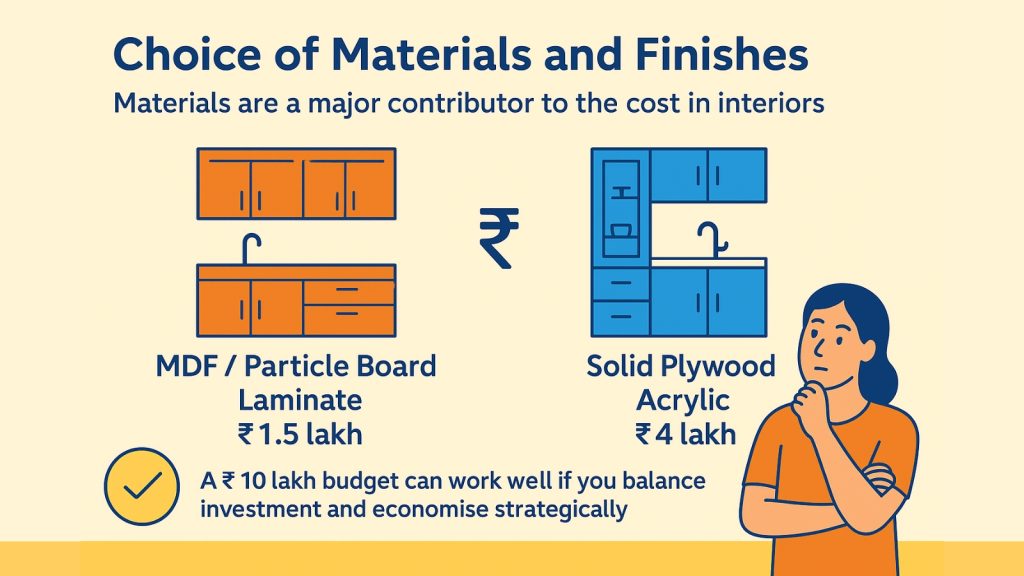
Materials are the quiet, yet major contributor to the cost in interiors. You could have two kitchens of identical size and design, but one costs ₹1.5 lakh while the other crosses ₹4 lakh, simply because of material choices. For example, MDF or particle board with laminate is more affordable than solid plywood with premium acrylic or PU finishes. Similarly, quartz countertops cost more than granite, and branded hardware significantly outprices local options.
This doesn’t mean you have to compromise on quality. But it does mean you need to be intentional. Prioritise durability in high-use areas (like kitchens and wardrobes), and be strategic about where you can save with simpler finishes. A ₹10 lakh budget can work well if you’re willing to balance where you invest and where you economise, and if you choose ideas relating to design of your house interiors.
This doesn’t mean you have to compromise on quality. But it does mean you need to be intentional. Prioritise durability in high-use areas (like kitchens and wardrobes), and be strategic about where you can save with simpler finishes. A ₹10 lakh budget can work well if you’re willing to balance where you invest and where you economise, and if you choose ideas relating to design of your house interiors.
5. Designer Fees vs Contractor Costs
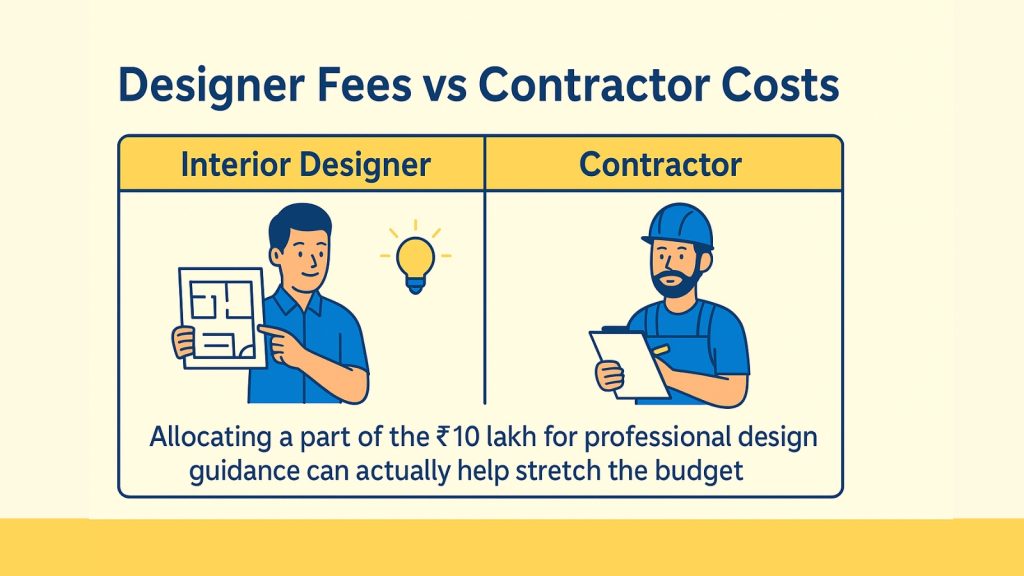
Eventually, many people overlook the difference between paying for design expertise and paying purely for execution.
The choice depends on how hands-on you want to be, and how comfortable you are making detailed decisions. For many homeowners, allocating a part of the ₹10 lakh for professional design guidance can actually help stretch the budget further by avoiding costly rework or poor-quality outcomes.
- If you’re hiring an experienced interior designer, part of your budget will go to their design fees. That fee isn’t just for drawings, it covers concept development, space planning, finish selections, vendor coordination, and quality checks. It brings value by reducing mistakes and guaranteeing cohesive and comprehensive results.
- If you go directly to a contractor or modular vendor, you may avoid design fees, but you’ll often have to manage planning and decision-making yourself. While this can save money upfront, it sometimes leads to disjointed designs or hidden costs that emerge during execution.
The choice depends on how hands-on you want to be, and how comfortable you are making detailed decisions. For many homeowners, allocating a part of the ₹10 lakh for professional design guidance can actually help stretch the budget further by avoiding costly rework or poor-quality outcomes.
Typical Home Interior Designer Cost in India
1 BHK Cost Estimate
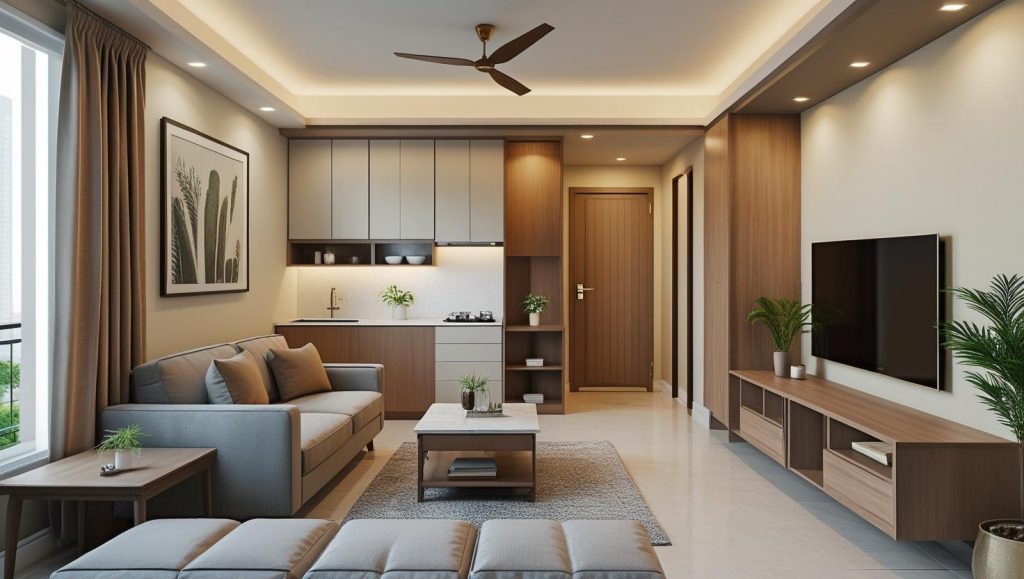
A 1 BHK is usually the easiest to fit within a ₹10 lakh budget, especially in Tier 2 cities or when you’re opting for simpler finishes. For many homeowners, ₹5–8 lakh can comfortably cover the essentials:
If you’re aiming for higher-end finishes or custom interior design designs, it can quickly approach ₹10–12 lakh, particularly in metros. The key is prioritising function and durability while being selective with upgrades.
- Modular kitchen with basic finishes
- Wardrobes for one bedroom
- TV unit or minimal living room storage
- Painting and lighting
If you’re aiming for higher-end finishes or custom interior design designs, it can quickly approach ₹10–12 lakh, particularly in metros. The key is prioritising function and durability while being selective with upgrades.
2 BHK Cost Estimate
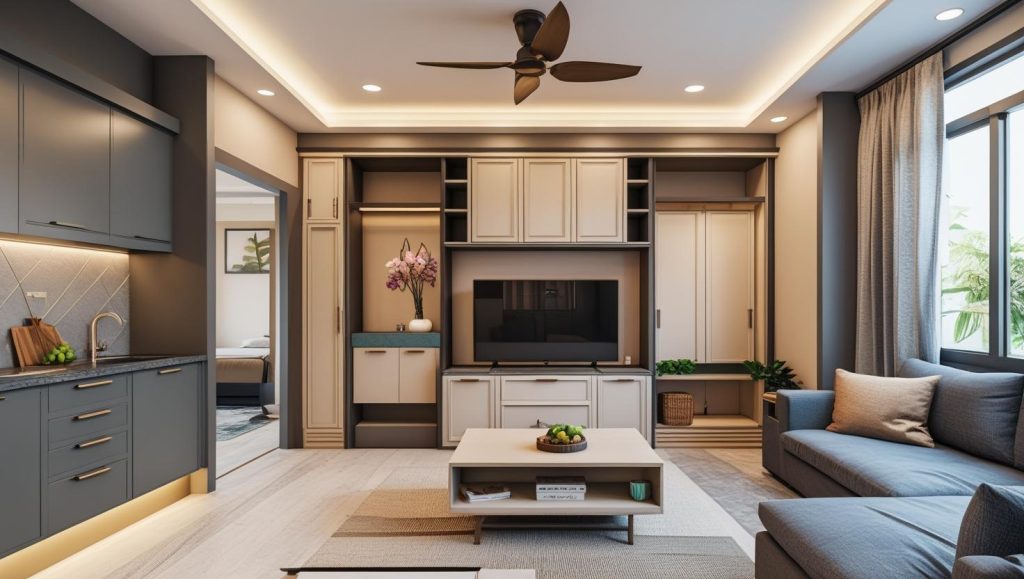
A 2 BHK generally requires a budget between ₹8–15 lakh, based on material choices and your location. If you’re strategic, ₹10 lakh can often accommodate.
For homeowners who are seeking a detailed and premium look, like intricate carpentry, mood lighting, detailed ceilings, or luxury materials, you’d likely need ₹15 lakh or more. It’s important to distinguish early between what’s essential for you and what’s simple and aspirational.
- A functional modular kitchen
- Wardrobes in both bedrooms (with basic to mid-range finishes)
- TV unit or minimal living room cabinetry
- Basic false ceiling or lighting upgrades
- Painting and surface finishes
For homeowners who are seeking a detailed and premium look, like intricate carpentry, mood lighting, detailed ceilings, or luxury materials, you’d likely need ₹15 lakh or more. It’s important to distinguish early between what’s essential for you and what’s simple and aspirational.
3 BHK Cost Estimate
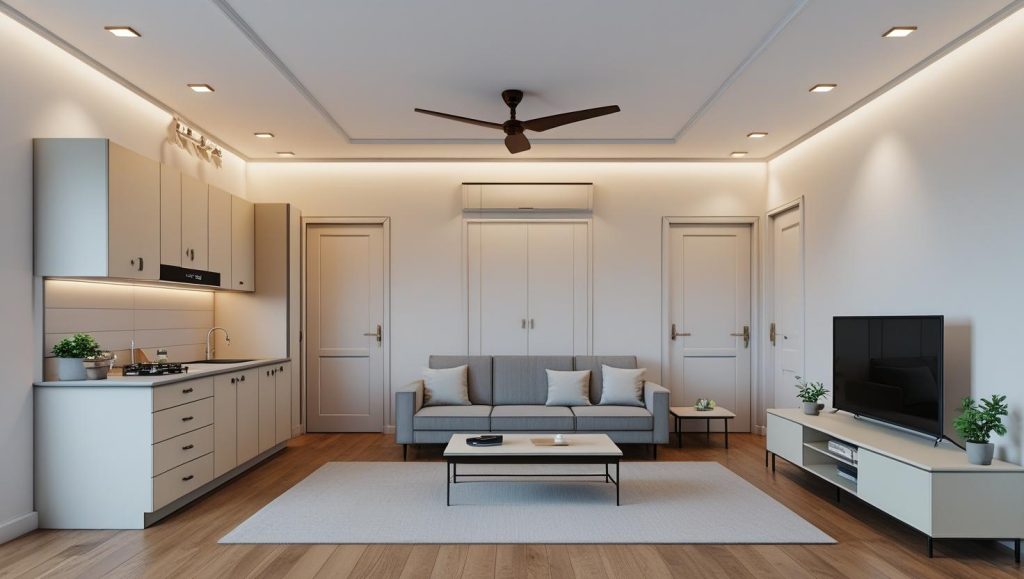
For a 3 BHK, ₹10 lakh generally covers only the basics if you plan carefully. A full-fledged home interior design for such a space often ranges from ₹12–20 lakh for a more complete outcome. Within a ₹10 lakh budgets, you might expect:
You’ll likely need to prioritise key spaces, perhaps completing essential rooms first, and phasing the rest over time. Phased planning is a smart approach to managing both design quality and budget.
- Basic modular kitchen (avoiding premium or imported finishes)
- Wardrobes in two bedrooms or simpler designs across all three
- Minimal living room furniture
- Standard painting and general lighting
You’ll likely need to prioritise key spaces, perhaps completing essential rooms first, and phasing the rest over time. Phased planning is a smart approach to managing both design quality and budget.
Modular Kitchen Costs
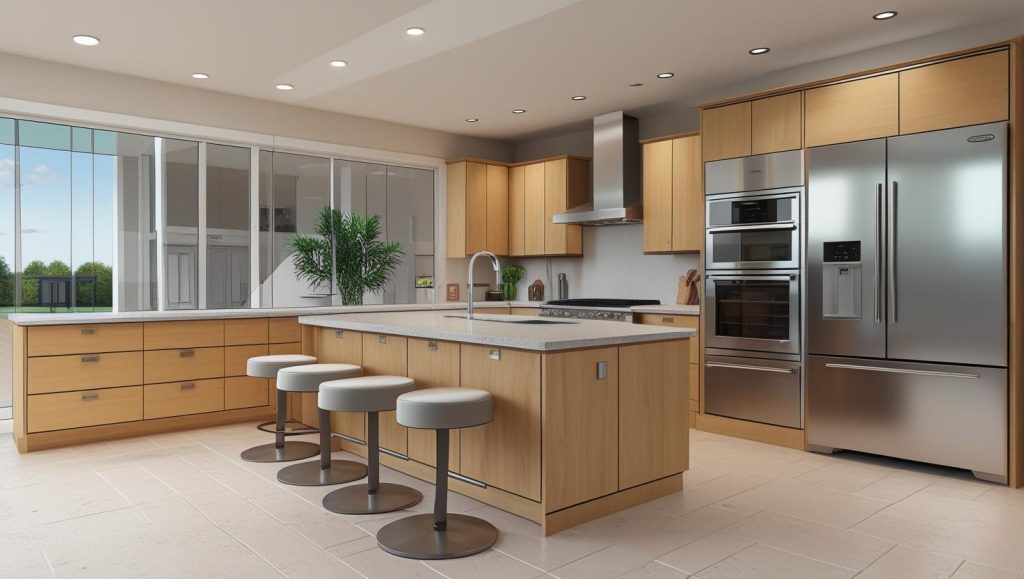
Kitchens are one of the biggest ticket items (the most cost intensive aspects) in any home interior project. A basic modular kitchen may start at ₹1.5–2 lakh when using laminate finishes and budget-friendly hardware.
If you’re leaning toward more durable options, like solid plywood, branded accessories, or finishes like acrylic or PU, the cost can easily rise to ₹3–5 lakh or more, specifically in larger kitchens. For many homeowners, deciding on the right balance between budget and quality in the kitchen is one of the most critical choices in planning interiors.
If you’re leaning toward more durable options, like solid plywood, branded accessories, or finishes like acrylic or PU, the cost can easily rise to ₹3–5 lakh or more, specifically in larger kitchens. For many homeowners, deciding on the right balance between budget and quality in the kitchen is one of the most critical choices in planning interiors.
Wardrobes and Storage
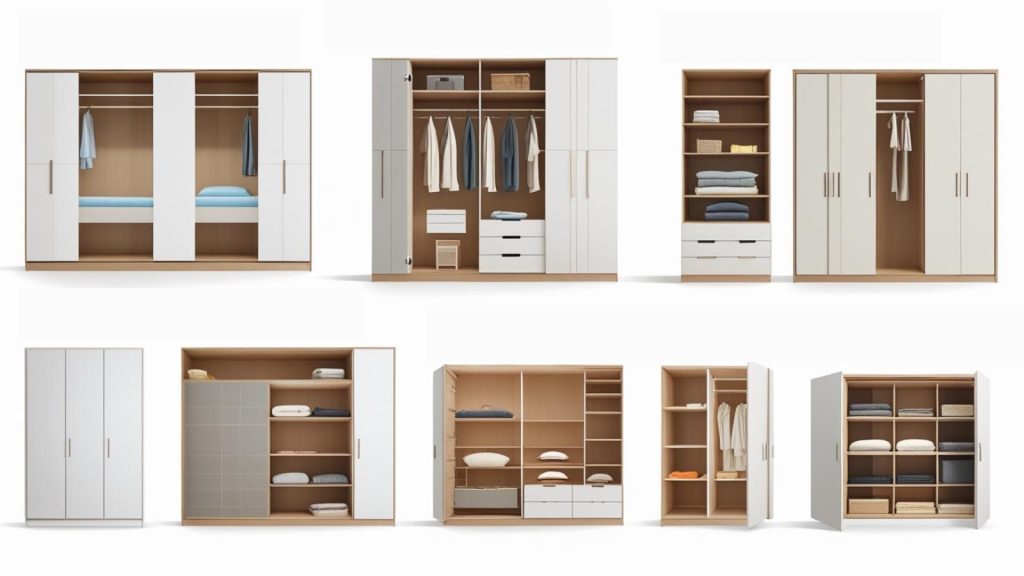
Wardrobes and built-in storage can take up a significant share of your budget. Basic laminate-finished wardrobes usually fall between ₹700–1,200 per sq. ft. A single bedroom’s wardrobe might cost ₹50,000–80,000, based on size. Multiply that by two or three bedrooms, and you see how quickly it adds up. Custom internal layouts, better materials, sliding doors, or loft storage will all increase costs.
Smart planning, like standardising wardrobe modules or using simple finishes, assists optimise storage avoiding to inflate the cost of your home interior design.
Smart planning, like standardising wardrobe modules or using simple finishes, assists optimise storage avoiding to inflate the cost of your home interior design.
Painting and Finishes
Painting may seem small, but it matters for the final look and the entire feel of your home interiors. Basic emulsion paint for an apartment starts around ₹20–25 per square foot, translating to ₹30,000-50,000 for a 1,000 sq. ft. apartment.
If you want textured finishes, premium paints, or wallpaper features, costs increase significantly. It’s easy to underestimate these finishing touches. Yet they’re what give your home its personality and polish. Planning for them from the start avoids last-minute budget shocks.
If you want textured finishes, premium paints, or wallpaper features, costs increase significantly. It’s easy to underestimate these finishing touches. Yet they’re what give your home its personality and polish. Planning for them from the start avoids last-minute budget shocks.
How to Get the Best Value with a ₹10 Lakh Budget?
Working with a ₹10 lakh budget for interiors is entirely achievable, but only with the right planning and choices. Over the time, we’ve seen projects succeed beautifully at this range by staying disciplined about scope and being clear-eyed about priorities. Here are some practical ways to make your budget go further by not sacrificing quality especially where it matters the most.
1. Choose Modular Over Custom Where Possible
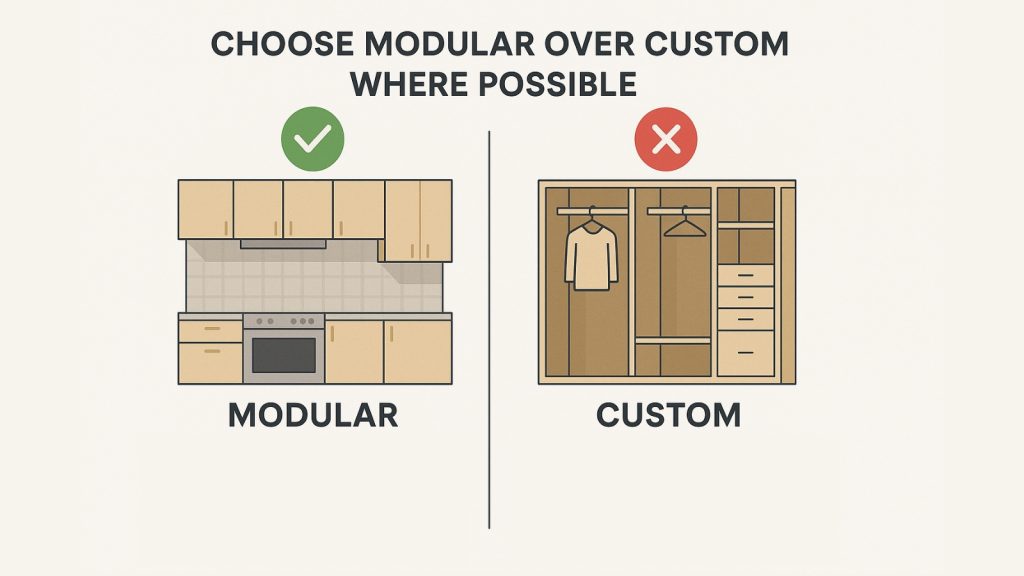
Modular solutions are among the easiest ways to manage your interior cost. Factory-made kitchens, wardrobes, and storage units offer standardised quality at a more accessible price than fully customised carpentry.
Custom designs deliver more flexibility but quickly increase labour and material costs. For most homeowners, well-planned modular systems strike a good balance between cost, function, and style.
Custom designs deliver more flexibility but quickly increase labour and material costs. For most homeowners, well-planned modular systems strike a good balance between cost, function, and style.
2. Prioritise High-Use Areas
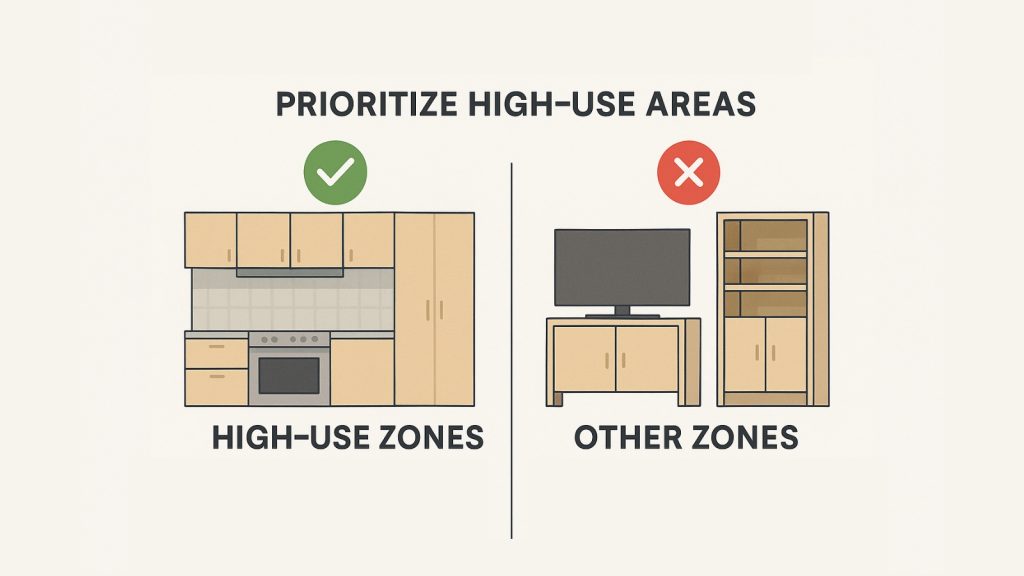
When your budget is tight, it’s vital to focus on the spaces you use every day. Kitchens and wardrobes face constant wear, so it’s worth investing in durable materials and reliable hardware here.
Other zones, like TV units, shoe racks, or spare bedroom storage, can use simpler designs or more cost-effective interior design ideas. This way, you maintain quality in the most critical spaces while staying within budget.
Other zones, like TV units, shoe racks, or spare bedroom storage, can use simpler designs or more cost-effective interior design ideas. This way, you maintain quality in the most critical spaces while staying within budget.
3. Compare Quotes from Designers

One common mistake is to assume all design services cost the same. Designer fees, contractor rates, and also the price of modular components can differ significantly between vendors, even in the same city. It pays to get multiple quotes, review detailed estimates, and understand exactly what’s included.
A good designer will be transparent about costs, help you avoid unnecessary extras, and suggest practical home design ideas feasible with your budget. You need not be afraid to ask questions or negotiate terms. This is your money, and clarity upfront can prevent disappointment later.
A good designer will be transparent about costs, help you avoid unnecessary extras, and suggest practical home design ideas feasible with your budget. You need not be afraid to ask questions or negotiate terms. This is your money, and clarity upfront can prevent disappointment later.
4. Don’t Forget Hidden Costs (Electrical, Civil Changes)

Many homeowners focus on visible elements like wardrobes and kitchen cabinets, and forget about the unseen costs that could quickly strain a budget. Electrical work, extra lighting points, plumbing adjustments, minor civil changes (like breaking walls or building partitions), and in fact disposal of old materials all add up.
It’s important to discuss these items early with your designer or contractor and ascertain that they’re included in your budget estimate. If you leave them out of your planning, it might end up risking unpleasant surprises, or worse. And you’d have to compromise on finishes to pay for essential work later.
It’s important to discuss these items early with your designer or contractor and ascertain that they’re included in your budget estimate. If you leave them out of your planning, it might end up risking unpleasant surprises, or worse. And you’d have to compromise on finishes to pay for essential work later.
5. Leverage Packages and Discounts

Many reputable design firms and modular vendors offer bundled packages that cover multiple rooms or full-home solutions at a discounted rate. These packages are often well thought-out, delivering standardised but quality finishes that make budgeting predictable and help avoid fragmented, mismatched design.
It is suggested to look for seasonal promotions, bulk discounts, or negotiated deals for hardware and accessories. While you should always check the quality being offered, these package deals can often deliver strong value and keep the cost of the overall home interior under control.
It is suggested to look for seasonal promotions, bulk discounts, or negotiated deals for hardware and accessories. While you should always check the quality being offered, these package deals can often deliver strong value and keep the cost of the overall home interior under control.
Expert Tips to Stretch Your ₹10 Lakh Budget
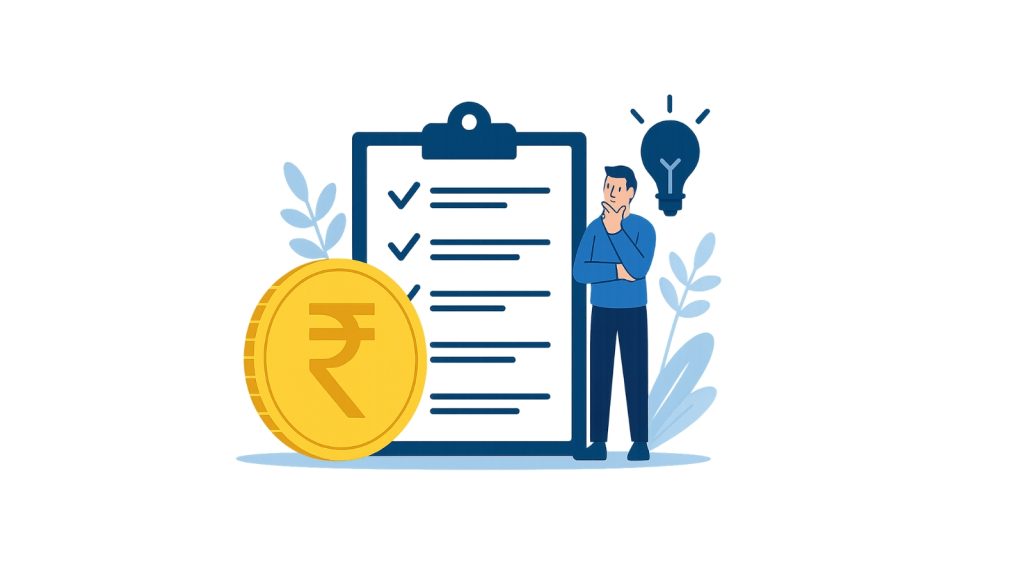
- Start by defining your must-haves early. When you clearly prioritise your plan and your requirement, it helps avoid expensive last-minute changes and keep your budget realistic.
- Compare suppliers and brands. Local vendors often render solid quality at better rates than big showrooms.
- Focus on essential spaces first, like kitchens and wardrobes. Plan to finish less-used areas later if needed.
- Handle simple tasks yourself, like painting or assembling furniture. This way you can reduce labour costs and stretch your budget further.
How Can Opalspace Help You?
Opalspace helps you get the best from your budget with complete interior design services, ranging from modular kitchens and wardrobes to custom furniture, civil work, painting, and decor. Our team works with you to plan smart, choose quality materials, and create practical, beautiful spaces that truly feel like home. We’re here to simplify the process, avoid costly mistakes, and ensure every detail reflects your needs. The right design choices can transform everyday living, and that’s the difference Opalspace brings.

